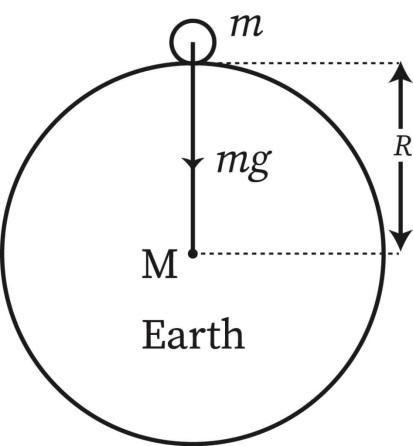Value of g - CGS, FPS, Earth, FAQs
Acceleration due to gravity, commonly denoted by g, is one of the most important concepts in Class 11 Physics and competitive exams like JEE and NEET. In this article, we will understand what g is, how it is derived, how it varies with height and depth, and how it differs from the universal gravitational constant G. You will also learn why objects fall at the same rate and how factors like altitude and Earth’s shape affect the value of g.
This Story also Contains
- What is Acceleration Due to Gravity (g)?
- Is g a Constant?
- Why Do Objects of Different Masses Fall at the Same Rate?
- Direction and Unit of g
- Relation Between g and G
- Mass, Radius, and Density of the Earth
- Variation of g-Factors Affecting Acceleration Due to Gravity
- Why is g Zero at the Centre of the Earth?

Also check-
What is Acceleration Due to Gravity (g)?
According to Newton's Second Law, a force $\mathbf{F}$ acting on a mass $\mathbf{m}$ produces acceleration a:
$
F=m a
$
If this force is due to the Earth's gravity, the acceleration produced is called acceleration due to gravity, represented by $\mathbf{g}$ :
$
F=m g
$
Thus, $g$ is the acceleration experienced by a body when it freely falls under the Earth's gravitational pull.
Is g a Constant?
Unlike $\mathbf{G}$ (universal gravitational constant), $\mathbf{g}$ is NOT constant everywhere.
The value of $g$ changes due to:
- Altitude (height above Earth)
- Depth below Earth
- Shape of Earth
- Rotation of Earth
However, a standard value is used for calculations:
$
g=9.8 \mathrm{~m} / \mathrm{s}^2
$
Why Do Objects of Different Masses Fall at the Same Rate?
The value of $g$ does not depend on the mass, size, or shape of the falling body.
This is why, as Galileo demonstrated, two objects dropped from the same height reach the ground at the same time (ignoring air resistance).
Air resistance (upthrust) is the only reason larger objects fall slower.
Direction and Unit of g
- Direction: Always toward the center of the Earth.
- SI Unit: $m / s^2$ or $N / k g$
- Dimensional Formula: $M^0 L^1 T^{-2}$
Relation Between g and G
Let us consider earth to be a sphere of mass M, radius R with the centre of earth as O. Now, if a body of mass m is placed on the surface of earth, g is the acceleration due to gravity acting on it.

The gravitational force between Earth (mass M) and the body is:
$
F=\frac{G M m}{R^2}
$
But this force is also equal to $\mathbf{m g}$ :
$
m g=\frac{G M m}{R^2}
$
$
g=\frac{G M}{R^2}
$
g depends on Earth’s mass (M) and Earth’s radius (R) not on the body’s mass.
Mass, Radius, and Density of the Earth
Using:
$
g=\frac{G M}{R^2}
$
We can calculate Earth's mass:
$
M=\frac{g R^2}{G}
$
For radius $R=6400 \mathrm{~km}$,
$
M \approx 6.0 \times 10^{24} \mathrm{~kg}
$
Density:
$
\rho=\frac{3 M}{4 \pi R^3}
$
Variation of g-Factors Affecting Acceleration Due to Gravity
Acceleration due to gravity changes with height, depth, and Earth's shape.
Let's understand each case.
1. Variation of g With Height (Altitude)
At Earth's surface:
$
g=\frac{G M}{R^2}
$
At height $h$ above the surface:
$
g^{\prime}=\frac{G M}{(R+h)^2}
$
For small heights ( $h \ll R$ ):
$
g^{\prime}=g\left(1-\frac{2 h}{R}\right)
$
g decreases with increase in height - this is why gravity is slightly weaker on mountains.
2. Variation of g With Depth
At Earth's surface:
$
g=\frac{G M}{R^2}
$
At depth $\mathbf{d}$ :
$
g^{\prime}=g\left(1-\frac{d}{R}\right)
$
g decreases linearly with depth and becomes zero at Earth's center.
3. Variation of g Due to Earth's Shape
Earth is not a perfect sphere; it is an oblate spheroid:
- Radius at equator: larger
- Radius at poles: smaller
Since:
$
g \propto \frac{1}{R^2}
$
g is maximum at poles and minimum at the equator.
Also Read:
Why is g Zero at the Centre of the Earth?
At the centre, gravitational pull from all sides cancels out, resulting in:
$
g=0
$
Summary
- $\mathrm{g}=9.8 \mathrm{~m} / \mathrm{s}^2$ near Earth's surface
- g varies with height, depth, and Earth's radius
- $g$ is maximum at poles and minimum at equator
- g becomes zero at Earth's centre
- Objects fall at the same rate because $g$ is independent of mass
Also read -
- NCERT Solutions for Class 11 Physics
- NCERT Solutions for Class 12 Physics
- NCERT Solutions for All Subjects
NCERT Physics Notes:
Frequently Asked Questions (FAQs)
Decrease in value of g is- g-g’=2hg/R.
Thus fractional decrease in value of g is (g-g’)/g=2h/R
Then, percentage decrease in value of g= [(g-g’)/g]×100=[2h/R]×100
If gravity suddenly disappears,
all the bodies will be suddenly thrown away from the surface due to earth’s centrifugal
force.
Motion of the satellites around earth, both natural and artificial will not be possible as no centripetal force will be provided.
All the materials will lose their weights, etc.
Ability of a celestial body to hold its atmosphere depends on 2 factors mainly- acceleration due to gravity i.e. value of g and its surface temperature.
1.625meter per second squared.
Using equation-2 and putting values of the sun's mass and radius, the value of g on the sun
is found to be 274.13 meter per second squared.
In the FPS (Foot-Pound-Second) system, the unit of acceleration due to gravity g is:feet per second squared (ft/s²)
In the CGS system, the unit of g is:
cm/s² (centimeter per second squared)
The acceleration due to gravity g is affected by:
Height (altitude): g decreases with height
Depth below Earth’s surface: g decreases with depth
Latitude / shape of Earth: g is minimum at the equator and maximum at the poles
Earth’s rotation: reduces effective gravity, especially at the equator
Local geological variations: density of rocks below the surface